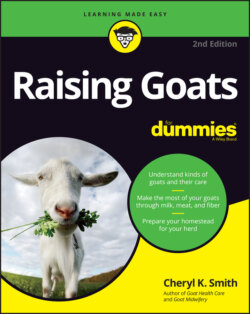Читать книгу Raising Goats For Dummies - Cheryl K. Smith - Страница 84
Cashmere
ОглавлениеCashmere goats in the United States aren’t a breed but a type of goat. What makes a goat a cashmere goat is that it produces cashmere. According to the Eastern Cashmere Association, feral goats from Australia and Spanish goats in the United States are both cashmere producers. They just need to have been bred to produce the right quality of cashmere, a measurement that is determined by the cashmere industry. (The fiber has to be less than 19 microns thick.) Most of the larger cashmere breeders originally imported high-quality fiber goats from Australia to start their herds.
Cashmere goats are dual fiber/meat goats. Like their non-cashmere feral relatives, they are quite hardy. But like dairy goats (and the Wicked Witch of the East) they don’t like rain and will run for shelter when it comes. Refer to Figure 3-7, which shows a Spanish cashmere goat.
U.S. cashmere goats are a little smaller than standard dairy goats but larger than Nigerians, making them a medium-sized goat. The bucks weigh about 150 pounds and does about 100 pounds at maturity. Like the Angora, they aren’t disbudded, because their horns help them regulate temperature so their heavy coats don’t overheat them.
The cashmere is actually their downy undercoat. Their outer coat, called guard hair, is quite coarse and isn’t used for fiber.
Cashmere production in the United States is still a small market, so if you get cashmere goats, you will be part of an elite group. Breeders with large herds remove the cashmere once a year, between December and March. That’s because it grows in response to light — from the summer solstice until the winter solstice. If you don’t have a lot of goats, you can just comb out the cashmere when it starts to shed. The average cashmere goat produces only about 4 ounces of cashmere per year.
